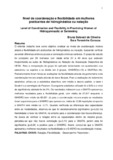| dc.contributor.advisor | Corazza, Sara Teresinha | |
| dc.creator | Oliveira, Bruna Delevati de | |
| dc.date.accessioned | 2018-03-21T14:51:24Z | |
| dc.date.available | 2018-03-21T14:51:24Z | |
| dc.date.issued | 2007-02-15 | |
| dc.date.submitted | 2007 | |
| dc.identifier.uri | http://repositorio.ufsm.br/handle/1/12774 | |
| dc.description | Artigo (especialização) - Universidade Federal de Santa Maria, Centro de Educação Física e Desportos, Curso de Especialização em Atividade Física, Desempenho Motor e Saúde, RS, 2007. | por |
| dc.description.abstract | The present paper had the purpose of analyzing the levels of wide motor
coordination and flexibility in apprentices of gymnastics or swimming aiming at verifying
if there is difference among the groups and correlation among the variables. The group
of study has been composed of 29 women aging between 21 and 40 years old enrolled
in the classes of hidrogymnastic or of swimming of the Sport Association of UFSM. A
questionnaire has been firstly applied in order to compose the group, selecting the
subjects and separating them in two groups: GHIDRO (n=15) e GNATA (n=14).
Subsequently, the evaluations of flexibility have been made through the goniometry
and the wide motor coordination by using the Burpee test. The descriptive statistics
with average and standard deviation, the Student test “t”, and the Pearson’s correlation
were the proceedings applied for the accomplishment of the statistic treatment. The
SAS was the statistic program applied and the level of significance adopted was of 5%.
The results have shown that the GNATA presented better results for the general
flexibility with average of 67,81º while the GHIDRO had an average of 63,23º. On the
other hand, the wide motor coordination had higher results for the GHIDRO which
presented average of 12,86 repetitions while the GNATA had average of 11,71.
Starting from the verification of the differences of capacities among the modalities, it
was possible to observe that they were statistically significant (p=0,03) in the flexibility
favorable to GNATA. However, there was no difference for the motor coordination. In
the attempt of verifying the relation among the capacities within the same group we
have noticed that there was no correlation (p=0,11) for the GNATA. Although, that
correlation was significant (p=0,04) and positive for GHIDRO. Therefore, it was
concluded that the GNATA showed better results regarding flexibility and the
GHIDRO regarding motor coordenation. | eng |
| dc.language | por | por |
| dc.publisher | Universidade Federal de Santa Maria | por |
| dc.rights | Acesso Aberto | por |
| dc.rights | Attribution-NonCommercial-NoDerivatives 4.0 International | * |
| dc.rights.uri | http://creativecommons.org/licenses/by-nc-nd/4.0/ | * |
| dc.subject | Natação | por |
| dc.subject | Flexibilidade | por |
| dc.subject | Desempenho psicomotor | por |
| dc.subject | Swmming | eng |
| dc.subject | Flexibility | eng |
| dc.subject | Psychomotor performance | eng |
| dc.title | Nível de coordenação e flexibilidade em mulheres praticantes de hidroginástica ou natação | por |
| dc.title.alternative | Level of coordination and flexibility in practicing women of hidrogymnastic or swimming | eng |
| dc.type | Trabalho de Conclusão de Curso de Especialização | por |
| dc.degree.local | Santa Maria, RS, Brasil | por |
| dc.degree.specialization | Atividade Física, Desempenho Motor e Saúde | por |
| dc.description.resumo | O referido trabalho teve como objetivo analisar os níveis de coordenação motora
ampla e flexibilidade em praticantes de hidroginástica ou natação, buscando verificar
se existe diferença entre os grupos e correlação entre as variáveis. O grupo de estudo
foi composto por 29 mulheres com idade entre 21 e 40 anos que estavam
freqüentando as aulas de Hidroginástica ou Natação da Associação Desportiva da
UFSM. Para a composição do grupo foi aplicado inicialmente um questionário que
selecionou os sujeitos e os dividiu em 2 grupos, GHIDRO(n=15) e GNATA(n=14).
Posteriormente foram feitas as avaliações da flexibilidade através da goniometria e da
coordenação motora ampla através do teste Burpee. Para a realização do tratamento
estatístico utilizou-se a estatística descritiva com média e desvio padrão, o teste t
Student e a correlação de Pearson. O programa estatístico utilizado foi o SAS e o nível
de significância adotado foi de 5%. Os resultados indicaram que o GNATA apresentou
melhores resultados para a flexibilidade geral, com média de 67,81º enquanto o
GHIDRO teve média de 63,23º. Já para a coordenação motora ampla os resultados
foram superiores para o GHIDRO que apresentou média de 12,86 repetições enquanto
o GNATA teve média de 11,71. Quando verificada as diferenças das capacidades
entre as modalidades, observou-se que foi estatisticamente significativa (p=0,03) na
flexibilidade à favor do GNATA, no entanto para a coordenação não houve diferença.
Na busca de verificar a relação entre as capacidades dentro do mesmo grupo,
percebeu-se que não houve correlação (p=0,11) para o GNATA, porém esta foi
significativa (p=0,04) e positiva para o GHIDRO. Assim, conclui-se que o GNATA
apresentou melhores resultados na flexibilidade e o GHIDRO na coordenação motora. | por |
| dc.publisher.country | Brasil | por |
| dc.publisher.initials | UFSM | por |
| dc.subject.cnpq | CNPQ::CIENCIAS DA SAUDE::EDUCACAO FISICA | por |
| dc.publisher.unidade | Centro de Educação Física e Desportos | por |



